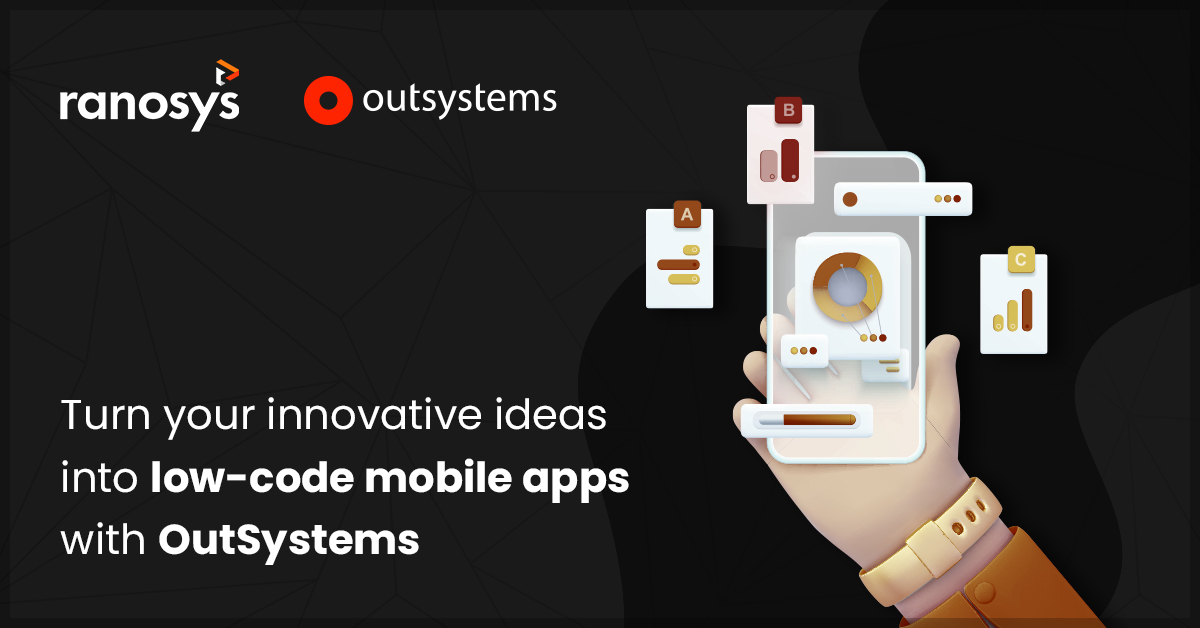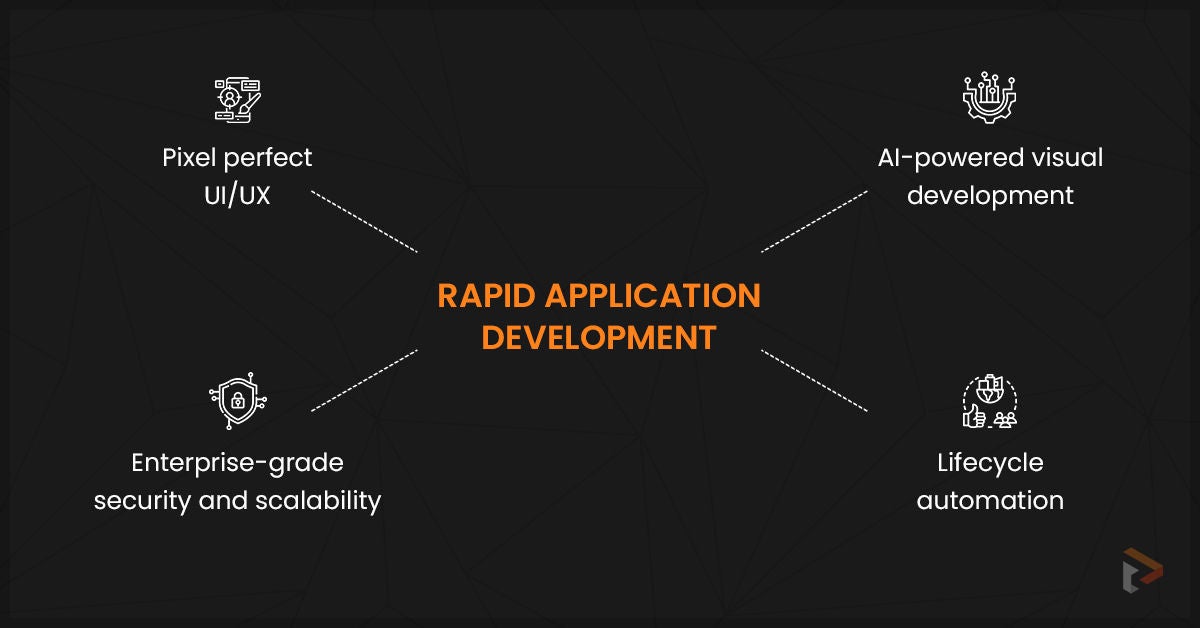- OutSystems delivers enterprise-grade applications six times faster than manual coding.
- The OutSystems platform delivers new features across the full application lifecycle.
- With a fully integrated UI framework, OutSystems builds beautiful, user-friendly applications that run across all devices and screens.
- OutSystems low-code platform delivers advanced, end-to-end applications with full-stack support for successful front-end development.
- The low-code platform OutSystems easily integrates complex existing systems with your own for development without boundaries.
- Enterprise-grade architecture-deliver applications built for the enterprise with scalability, security, reliability, and governance.
Challenges faced while developing mobile applications: How OutSystems helps
Some of the common challenges in mobile application development faced by enterprises are integrating different systems, technologies, and ecosystems and a lack of involvement by business users. Even developers don’t want to spend time tracking bugs, debugging them, and coding hard as they wish to prioritize more value-added tasks such as security analysis, testing and gauging software requirements, and designing software.
Companies are looking for ways to build applications faster in response to the ever-increasing developer workloads and changing business needs. At the same time, the OutSystems platform is already capable of solving a broad range of customer solutions, such as application modernization and workplace innovations to business process automation. Let’s discuss some of the major challenges in mobile application development and how OutSystems benefits them:
#1. Need for secure mobile applications
Nowadays, almost every industry relies on mobile applications like banking, healthcare, government, insurance, education, fashion, and many more. Investing in mobile app security helps protect users' data and secure applications from external threats such as hacking. Mobile applications available in app stores might not be fully secured, as said, and hence users get exposed to malicious attacks or data breaches. In recent years cybercriminals have been targeting B2C applications more aggressively than ever before, leading to downtime, intellectual property theft, and hefty regulatory fines. Therefore, businesses should understand the criticality of integrating security while developing mission-critical applications.
How OutSystems helps:
- OutSystems includes a comprehensive set of built-in security features that supports the complete development lifecycle of an application and helps in DevOps processes, laying the foundation for a secure SDLC. Apps developed with this platform automatically include secure code patterns that safeguard against prevalent mobile application vulnerabilities.
- OutSystems provides automated application security checks that warn developers about potential security risks when they publish applications. OutSystems also complies with other general security requirements such as identity management, access control, encryption, single sign-on, etc.
- To help you build safe and secure applications, OutSystems offers AppShield, an additional cost add-on, which adds a layer of security. AppShield reduces potential risks, avoids regulatory fines, reduces manual coding work, and protects against data leaks. It includes native code obfuscation, root detection, repackaging, code injection protection, emulator detection, and keylogger protection securing mobile apps at rest or run time.
#2. Interactive UX
Today’s users have little patience to put up with slow loads, complicated navigation, incomplete information, or glitches which often leads to an unsatisfactory and inefficient experience. Businesses are trying to provide mobile apps that are easy to use and solve a user’s problem. Also, a user should be able to understand the UI/UX enough to spend time on applications. An engaging user interaction enhances brand image and boosts sales.
How OutSystems helps:
- OutSystems platform delivers mobile apps with an attractive user interface via an fully-integrated UI framework called OutSystems UI that offers customizable themes for mobile apps.
- Outsystems mobile app development includes a huge library of samples and patterns through which you can get amazing mobile apps having a magnificent look and feel.
- OutSystems have features that enable you to provide modern UI/UX experiences like a drag-and-drop editor, grid and flex layouts, smart vertical spacing, and accelerators, such as UI patterns and screen templates, to build different mobile screens rapidly.
- The screen editor of OutSystems gives a perfect real-time preview of designs on multiple screens, to deliver responsive experiences across devices.
#3. Simplified developmental approach
Businesses need their applications to be developed rapidly, efficiently, and at budgeted costs. The obstacle is that many companies still use legacy systems to build applications that affect business continuity and reliability. Also, it has a domino effect where one problem can lead to another. Legacy systems are common bottlenecks that require huge maintenance costs. Hence, enterprises need legacy modernization to reduce costs and improve flexibility, collaboration, and consistency.
How OutSystems helps:
- As OutSystems produces highly performant hybrid applications, you can deliver your mobile app to multiple operating systems faster. An application developed with OutSystems can easily run on both iOS and Android devices. There is no need to adapt the code for each type of device.
- Manual coding consumes a lot of time and effort for a developer, leading to increased costs and development time. However, when applications are developed on OutSystems, the development speed increases by almost ten times. Hence, by considerably reducing application development time, OutSystems allows organizations to save costs in the long run.
- Mobile apps developed on the OutSystems platform can access all of the native capabilities and APIs of the device (be it Android or iOS) by using plugins. The capabilities are limited to cameras, geolocation, and notifications and include Bluetooth, barcode scanners, and more.
- OutSystems has all the tools required to develop applications that run offline. Mobile apps developed with OutSystems automatically store all the app content on the device so that it can be easily accessed for offline use.
#4. Difficulty in integration
Enterprises usually face a big time issue seamlessly integrating their existing systems with external ones and building a single source of truth for data and ongoing operations. Such problems can lead to frustrations and doubts about limited or buggy solutions and digital transformation overall.
How OutSystems helps:
- OutSystems provides tools to simplify the integration and synchronization of multiple data sources of REST APIs, SOAP web services, and external database connections.
- OutSystems can use open-source components and easily integrates with external enterprise systems, databases, or custom apps.
5 mobile application development pillars and major OutSystems trends
Many enterprises are leveraging the OutSystems low-code platform to create front-end and back-end applications and digitizing end-to-end processes. Therefore, OutSystems is an optimal solution to create highly functional and complex applications at scale in less time. To meet the expectations of customers, businesses need to look for these four core pillars of building applications:
- Developer experience
- Workflow automation
- Security and Compliance
- Development and operations
Based on these four pillars OutSystems has predicted 5 application development trends to look out for before modernizing their teams, dev practices, and tools to achieve their goals. They are:
- DevSecOps: Security and compliance requirements are validated at every stage of the development cycle.
- Hybrid integrations: Organizations need to connect real-time data management, governance, and auditability across multiple touch points, which begs for more tools in hybrid integrations supporting businesses to make data-driven decisions.
- Cloud-native platforms: To implement business agility, you need to develop cloud-native applications, one that is highly distributed and scalable and enables the creation of resilient and fit-to-purpose enterprise apps.
- DesignOps: Design at scale while minimizing technical complexity, meeting business goals, and creating amazing UX.
- PWA-first: Progressive web apps combine functions of both native apps and websites. As it uses a single code base for all devices and is searchable and light, it is way faster than native apps while being easy to maintain.
Accelerate mobile application development with a trusted partner of OutSystems
So far, OutSystems is one of the best solutions which combines the power of low-code mobile app development with advanced mobile functionalities. Through a focused approach on intuitive user experience, easy integration, and building fast applications, OutSystems platform has laid a solid foundation in developing mobile applications. At Ranosys, we have assisted several enterprises to build their mobile applications and we can solve your business use cases too. Connect with our certified experts to know how OutSystems can revolutionize your business operations.





